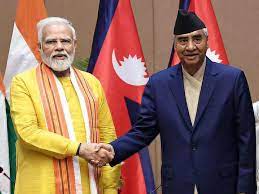20 May 2022 Visit of Indian Prime Minister to Nepal

Visit of Indian Prime Minister to Nepal – Today Current Affairs
- Recently the Indian Prime Minister has visited Lumbini, Nepal, the birthplace of Buddha, where he along with the Prime Minister of Nepal laid the foundation stone for the construction of a Buddhist Vihara, which will be built with India’s assistance.
- The Prime Minister participated in the 2566th Buddha Jayanti celebrations and addressed a gathering of Buddhist scholars and monks from Nepal and India.
- The Prime Minister praised Nepal for preserving its ancient culture and civilization and said that India-Nepal relations are as strong and ancient as the Himalayas.
Today Current Affairs
Highlights of the trip:
International Center for Buddhist Culture and Heritage:
- The Prime Minister laid the foundation stone for the construction of India International Center for Buddhist Culture and Heritage in Lumbini Monastery, Nepal.
- The center will be equipped with world-class facilities to welcome pilgrims and tourists from all over the world to enjoy the essence of the spiritual aspects of Buddhism.
- It aims to serve scholars and Buddhist pilgrims visiting Lumbini from all over the world.
Hydroelectric Projects : The Hindu Analysis
- The two countries signed five agreements between Sutlej Hydro-Vidyut Nigam (SJVN) Limited and Nepal Electricity Authority (NEA) for the development and implementation of 490.2 megawatt (MW) Arun-4 hydro-electric project.
- Nepal also invited Indian companies to invest in Paschim Seti Hydroelectric Project in Nepal.
Setting up of Satellite Complex : The Hindu Analysis
- India has offered to set up a satellite campus of the Indian Institute of Technology (IIT) at Rupandehi and has sent some MoUs between Indian and Nepalese universities for signing.
Pancheshwar Multipurpose Project : The Hindu Analysis
- Nepal has some pending projects like Pancheshwar Multipurpose Project, an important branch of the Mahakali Treaty signed between Nepal and India in 1996 and Paschim Seti Hydroelectric Project, a reservoir-type power project with an estimated capacity of 1,200 megawatt (MW), also discussed.
India’s erstwhile relations with Nepal : The Hindu Analysis
- The Indo-Nepal Treaty of Peace and Friendship of 1950 has been the cornerstone of the special relationship that exists between the two countries.
- Nepal is an important neighbor of India and due to its geographical, historical, cultural and economic ties spanning centuries, it also holds special importance in our foreign policy.
- India and Nepal share similar relations in terms of Hinduism and Buddhism, it is noteworthy that the birthplace of Buddha is in Lumbini Nepal and his place of Nirvana is located in Kushinagar India.
- There has been some deterioration in India’s relations with Nepal in recent years. In 2015, India was blamed for interfering with Nepal’s constitution drafting process and then for an “informal blockade”, which sparked widespread outrage against India. The Hindu Analysis
- In the year 2017, Nepal signed China’s Belt and Road Initiative (BRI), to build highways, airports and other infrastructure in Nepal. BRI was rejected by India and Nepal’s move was seen as leaning towards China.
- In the year 2019, Nepal released a new political map claiming Kalapani, Limpiyadhura and Lipulekh and Susta (West Champaran district, Bihar) regions of Uttarakhand as part of Nepal.
Barriers to India-Nepal relations:
Territorial disputes : The Hindu Analysis
- A major obstacle in India-Nepal relations is the Kalapani border dispute. These boundaries were determined by the British in the year 1816 and India inherited the territories over which the British held territorial control until 1947.
- When 98% of the Indo-Nepal border was demarcated, this work remained incomplete in two areas – Susta and Kalapani.
- In the year 2019, Nepal released a new political map and claimed its claim on Kalapani, Limpiyadhura and Lipulekh in Uttarakhand and Susta region of West Champaran district of Bihar.
Problems inherent in the Treaty of Peace and Friendship : The Hindu Analysis
- The Indo-Nepal Peace and Friendship Treaty was signed by Nepal in the year 1950 with the aim of continuing its special relationship with British India with independent India and allowing them to open borders with India and work in India Enjoy the benefits of the right.
- But at present it is seen as an unequal relationship and Indian imposition.
- The idea of revising and updating it has been appearing in joint statements since the mid-1990s, but only in a sporadically and impassioned manner.
Demonetization bottleneck : The Hindu Analysis
- In November 2016, India announced demonetisation and withdrew 15.44 trillion rupees in the form of high denomination currency notes (₹1,000 and ₹500). Of these, Rs 15.3 trillion has also returned to the economy in the form of new notes.
- But in the process many Nepalese citizens who were legally entitled to hold an Indian currency of 25,000 rupees (given that the Nepalese rupee is pegged to the Indian rupee) were deprived of it.
- Nepal Rastra Bank (Nepal’s central bank) has 7 crore Indian Rupees and is estimated to have a public holding of 500 crore rupees.
- India’s refusal to accept demonetised bills with Nepal Rastra Bank and the unknown culmination of the report submitted by Eminent Persons Group (EPG) has not helped India’s image in Nepal.


No Comments